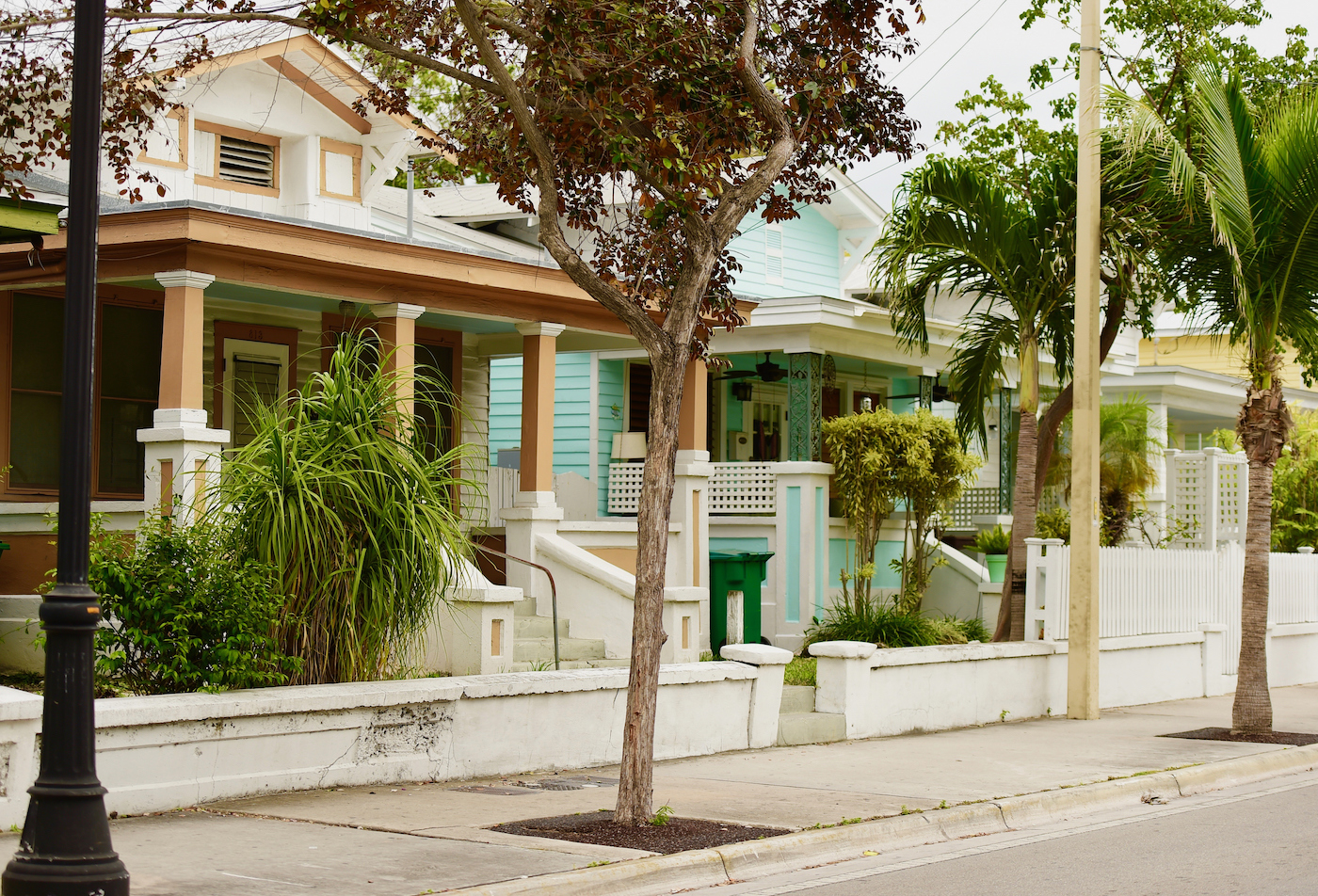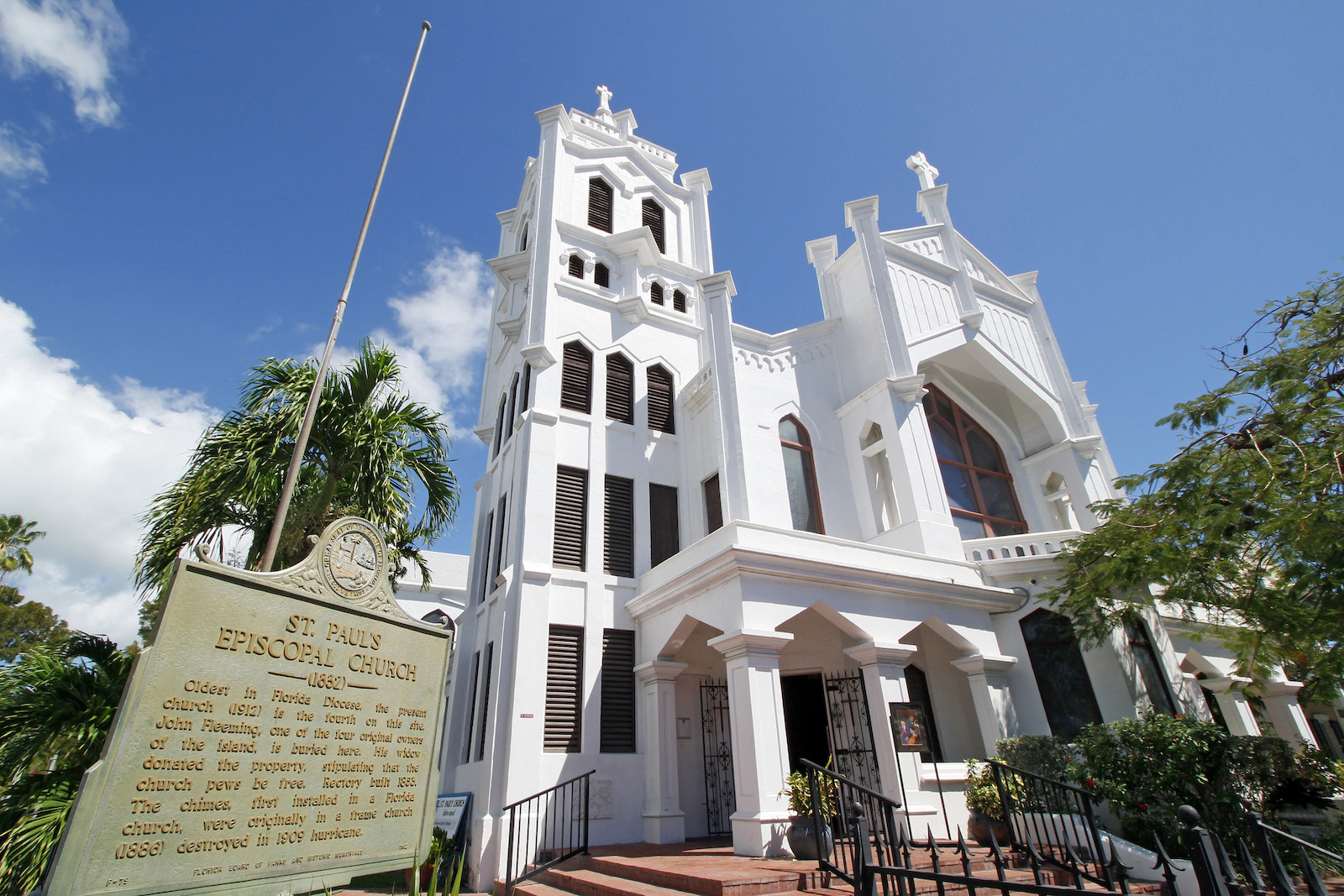This story was produced through a collaboration involving Southerly, Climate Central, and Newsy. It is republished here under a Creative Commons License.
Grounds cloaked in greenery weave around a towering ivory chapel in the heart of downtown Key West, Fla. Founded in 1832, St. Paul’s Episcopal Key West is not only the oldest Christian congregation in the area, but one of the oldest congregations of any religious tradition south of St. Augustine.
The church is on its fourth building, the first three lost to fires and a hurricane. After nearly two hundred years of its congregation working to keep it standing, Reverend Donna Mote, the newest rector at St. Paul’s, is now worried about a more subtle risk: rising seas.
“It would be a shame to preserve all these buildings, and then have people scuba diving in them in 100 years,” Mote said.
St. Paul’s is located on one of the highest points of Key West; one of the 1,700 islands that make up the Florida Keys, where 90 percent of the land mass sits only five feet above the Atlantic Ocean. While scuba divers won’t be visiting the church in the coming century, with seas rising and storms intensifying, the eight-square-mile island city is facing more frequent and chronic flooding.
Local officials and organizations are working to hold back the seawater climbing higher, threatening to plunge the area underwater by the turn of the century. But billion-dollar resilience projects in the pipeline — intended to raise roadways and flood-proof infrastructure to combat flood risk — will depend on community buy-in.
Just five months into her role at St. Paul’s, Mote intends to roll out a renewable energy audit of the church site to see how they can use cleaner energy. She also tries to set a sustainable example for her parishioners: She’s on a plant-based diet and encourages them to bike instead of drive, when possible.
While St. Paul Episcopal Key West sits on land high enough to protect it from all but the worst storm surges, a Climate Central analysis found that by 2080, rising seas will introduce a 1 percent annual chance of coastal flooding to the church’s property. That creates a one-in-four chance of a flood impacting the site every 30 years — a hazard so severe only 3 percent of the U.S. population currently lives in areas subject to this kind of risk.
Mote belongs to one of several faith-based communities in Florida turning their attention to climate action, making religious cases for environmental preservation, clean energy, and emissions reductions. At St. Gregory’s Episcopal Church in Boca Raton, parish members lead beach clean-ups. The First Presbyterian Church of Tallahassee donates to the city’s sustainability carbon fund as they seek to reduce their carbon footprint to net zero. The First Baptist Church of Orlando has been recognized by the U.S. Environmental Protection Agency for reducing pollution through energy efficiency.
Experts and faith leaders say provincial places of worship have a leading role to play in facilitating that support, and helping people engage in local environmental and justice issues. “We can either preach now to help people realize this,” said Ryan Gladwin, Palm Beach Atlantic University associate professor of ministry and theology. “Or we’re just going to have to be mourning with them, in the future, what we’ve lost.”
Key West is home to more than 24,000 permanent residents and attracts millions of tourists each year. Cobblestone walkways line tourist-saturated storefronts, adjacent to a sprawling, weathered dock overlooking the ocean. It’s picturesque until it starts to pour. Many locals are quick to name two converging streets downtown — Front and Greene — as frequent flood zones. In the lowest-lying parts of the longest island in the archipelago, heavy rainfall and high tides cause streets to flood, damage homes, and submerge vehicles. Monroe County expects another 17 inches of sea-level rise by 2040.
“The flooding has definitely been more than I’ve ever seen,” said Stephanie Piraino, manager at the Key West Key Lime Company, just a two-minute walk from the waterfront. Piraino said heavy rains can be brutal on the older properties and high tides often mean she’s taking her shoes off before wading through ankle-deep water in the parking lot.
Hurricane Irma swept through in 2017, the force of the Category 4 storm surge strong enough to flip the store’s giant hundred-pound freezers upside-down. “We had everything covered. We put tarps in front of everything, did the sandbags with wood next to the door, but there’s really no way around it,” she said. Up to a foot of seawater came in.
After Irma made landfall, Piraino remembers how a handful of local churches supplied donations to those in need. “Bug spray and charcoal saved the week for me and my kids,” she said.

She used to live in a trailer in the nearby community of Stock Island, where dealing with chronic flooding was just a part of life. “Every time there was a high tide, the water would flood so much that it would come all the way to my front porch,” she said. She’d often struggle with electrical outages because of seawater submerging parts of her mobile home.
With an average housing market value of just over $700,000, Key West is one of the most expensive cities to live in Florida. Workers need to earn $33 an hour to afford rental rates, according to the Florida Housing Data Clearinghouse. Although more than 11.6 percent of the population falls below the national poverty threshold, the city only has 390 properties set aside as affordable housing stock for those that can’t manage steep rental costs. Black, Indigenous, and Latinx people make up the highest proportions of extremely low-income renters. In Key West, where 37 percent of the population are Black or Hispanic, more than 43 percent of those residents live in poverty.
It’s those residents who feel the consequences of climate change more intensely. Post-disaster government assistance programs are structured in ways that disadvantage them. “The least expensive, or the most affordable housing, also tends to be the most unsafe,” said Tom Callahan, executive director of Monroe County’s Star of the Sea SOS Foundation, run by the local Catholic church, which distributes 2 million pounds of food every year to nearly 10,000 residents in the Keys.
Nonprofits and places of worship are critical resources for those community members reeling from a hurricane or flood. Churches are often a place of solace for residents seeking help, offering everything from food to housing repairs to counseling.
Many also serve as staging areas during a storm, or places to stay for emergency response volunteers. A 2020 FEMA assessment of faith-based responses to disasters found that after Hurricanes Katrina and Rita hit Louisiana, “local churches and community organizations often served disenfranchised groups missed by formal response efforts.”
The Star of the Sea Foundation lost its roof during Hurricane Irma; it took six months to rebuild. Restoration funding came partially from the Archdiocese of Miami, which is made up of 118 Catholic parishes and missions spread across South Florida. Archbishop Thomas Wenski oversees all of those coastal congregations, where he says people are reminded of climate change every time there’s a hurricane or high tides.
But as oceans rise, so do social divides. Climate gentrification is threatening affordable housing in Miami and across the region, as developers pour investment into premium elevation areas, pricing out existing residents.
Faced with employment instability, rising rent, and increasing floods, Callahan said a similar story is unfolding in Key West, as many moved north to find affordable housing options and work. Four percent of the Keys population left following the 2017 hurricane because of a lack of affordable housing options. Three years later, the coronavirus pandemic meant the islands were sealed off for months. Since then, many businesses have rebounded, but the recent, record-breaking surge of the COVID-19 delta variant in Florida has exacerbated the problems.
In June, Monroe County moved forward with a $1.8 billion plan to raise 150 miles of roads over the next 25 years. But that elevation solution will only apply to unincorporated roads in Monroe County, or non-governed areas outside of city limits.
Earlier this year, the U.S. Army Corps of Engineers released a storm risk management study for the Keys that proposed investing almost $3 billion into floodproofing infrastructure and elevating nearly 4,700 homes, 43 percent of which are located in Key West, costing the city about $1.2 billion. The federal government will cover 65 percent if it is approved by Congress. The proposal is being formally submitted soon, according to Monroe County Chief Resilience Officer Rhonda Haag.

“We have a list of infrastructure projects and we’re ready to move forward, but the biggest problem is the funding,” Haag said. Increased taxes will be likely. “We’re going to need the residents and businesses to work with us.”
Houses of worship could wield considerable influence on a small island. “Stories move people, right? And we know that pastors are very, very effective public speakers,” said Erum Sattar, a lecturer at Tufts University and a former Harvard Law Visiting Fellow of The Program on Law and Society in the Muslim World. “They can get to your heart and they can motivate action.”
But after working for the city for nine years and living in Key West for more than two decades, city of Key West sustainability coordinator Alison Higgins can only think of one local church that has been vocal about climate change.
That doesn’t mean it isn’t on their minds, though. “There’s no concern about flooding at this site, not at 11 feet above sea level,” said Reverend John Baker about the Basilica St. Mary Star of the Sea, one of the largest and oldest places of worship in Key West. “But if there’s a storm surge, it doesn’t matter if you’re 11, or 20, feet above sea level, you don’t know what’s gonna happen.”
A Climate Central analysis found that by 2070, about half the Basilica site will become subject to occasional flood risk. By 2080, the whole area will face at least a 1 percent annual chance of flooding. By century’s end, the likelihood of flooding for the more than 200-year-old church property will increase 10-fold.
Baker’s led the only Catholic church on the island for 14 years. He’s less worried about flood risk at the church, and more about the consequences of climate change for the region. Although he’s quick to cite Pope Francis’s 2015 encyclical, a landmark document credited with driving faith-based environmental action, Baker doesn’t believe it’s his role to engage his congregation on the need for climate action.
“I talk about Jesus Christ. And that’s why people come here. To discuss something that’s a controversial issue, you’re not bringing people together,” Baker said. “It’s best to not touch it because of that divisiveness,” he added.
A new study published in Environmental Research Letters found that over the last five years, a majority of U.S. Catholic bishops have been “nearly silent and sometimes even misleading,” in their official messaging to parishioners about climate change and the pope’s encyclical.
But a member of the Basilica St. Mary Star of the Sea’s congregation, Callahan, from the food bank, doesn’t think local government is doing enough to prepare for climate change, especially for the groups that need it most.
“Climate change is the 800-pound gorilla that the county is trying to ignore,” Callahan said. “But they have finally, most recently, at least, started looking at it.”
The city’s preparing an adaptation plan for vulnerable infrastructure, like the low-lying roads and historic buildings already enduring flooding, which they expect to be ready by 2023. They’re also collaborating with the U.S. Navy to map flood patterns by tracking high tide as it moves through the island.
“I think it’s kind of a good thing that we have been getting our feet wet once in a while,” said city sustainability coordinator Higgins. “You’re learning to live with that water because that’s what you’re going to have to do if this community is going to survive.”
Higgins hopes more religious sanctuaries will get involved with their adaptation and mitigation plans. “They’re an incredibly trusted messenger,” she said. She sees those collaborations as opportunities for local places of worship to help amplify support for such initiatives; including everything from urging their congregations to get involved with ongoing projects to planning events that promote them.
“They can call me anytime to come and talk to them about how we can work together.”
In the meantime, some faith leaders like Mote, from St. Paul’s Episcopal, are taking the moral call to environmental action more urgently. Mote has a background in disaster chaplaincy, or providing on-the-ground spiritual guidance to those affected by a crisis, such as a hurricane, and has trained other members of the clergy to be effective first responders.
“We are called to be on the ground in the wake of a disaster,” Mote said. “What about our role in addressing the factors that are leading to the increase of these disasters?”



